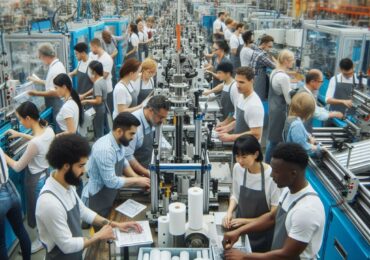Imagine a factory where machines talk to each other, robots anticipate problems before they arise, and production lines hum with effortless precision—without a single coffee break. Welcome to the age of smart factories, where manufacturing meets the future, and the future looks like a well-oiled, AI-driven, data-powered dream. A crucial component of this future is the Vision system for quality inspection, ensuring every product meets the highest standards. While the past industrial revolutions relied on steam, electricity, and computers, the fourth industrial revolution—also known as Industry 4.0—is powered by smart technologies that make traditional factories look like quaint relics of a bygone era.
The Brainpower Behind Smart Factories
At the heart of smart factories is an intricate network of interconnected systems driven by artificial intelligence (AI), machine learning (ML), the Internet of Things (IoT), and big data analytics. Think of it as a high-tech brain orchestrating every part of production with remarkable intelligence. Sensors embedded in machinery provide real-time data, AI algorithms optimize workflow, and automation ensures minimal human intervention. The result? Faster production times, higher efficiency, and fewer errors.
Less Downtime, More Productivity
Downtime is the archnemesis of manufacturing. Traditional factories often face unexpected breakdowns that cost companies millions in lost productivity. Enter predictive maintenance—a smart factory superpower. With real-time monitoring and AI-driven diagnostics, machines can alert technicians before a breakdown happens. It’s like your car texting you, “Hey, my brakes are feeling a little off—maybe fix me before we have a problem?” Smart factories use this proactive approach to prevent costly disruptions, keeping production running smoothly. To enhance this proactive approach, the Vision system for quality inspection plays a crucial role by continuously monitoring production lines for defects, allowing immediate adjustments, and minimizing downtime caused by quality issues.
Precision Like Never Before
Human error is a natural part of traditional manufacturing, but smart factories minimize its impact. Robots with AI and computer vision can assemble products with microscopic precision, reducing defects and increasing consistency. This isn’t just good news for manufacturers—it means consumers get better-quality products with fewer recalls. Smart factories ensure tighter quality control than ever before, whether it’s the smartphone in your pocket or the car in your driveway. Integral to achieving this higher quality control is the implementation of quality inspection software, which provides real-time, automated checks to ensure every product meets the highest standards, even at microscopic levels.
The Rise of Hyper-Personalization
Mass production is evolving into mass customization. Smart factories leverage AI and flexible production lines to personalize products at scale. Let’s say you order custom sneakers with your initials embroidered neon green. Instead of a tedious, manual process, a smart factory seamlessly integrates this request into the production schedule, ensuring your sneakers roll off the assembly line exactly as you envisioned. Consumers get tailor-made products without sacrificing efficiency—talk about having your cake and eating it too.
A Green Revolution in Manufacturing
Sustainability is no longer just a buzzword—it’s a business imperative. Smart factories help companies reduce waste, lower energy consumption, and optimize resources. With real-time energy monitoring, AI-driven efficiency improvements, and automated recycling systems, these factories contribute to a greener planet. Some even use digital twins—virtual replicas of physical production systems—to simulate and optimize production before real-world implementation, reducing trial-and-error waste. Smart manufacturing isn’t just smart for business—it’s smart for the environment, too.
The Human Touch in an Automated World
If robots are taking over factories, where does that leave humans? While automation reduces the need for repetitive, manual labor, it creates opportunities for higher-skilled roles. Workers are no longer just operators but technicians, engineers, and data analysts overseeing AI-driven systems. The result? A shift in workforce dynamics where human expertise focuses on creativity, problem-solving, and strategic decision-making rather than mundane, repetitive tasks.
The Road Ahead: Challenges and Opportunities
The transition to smart factories isn’t without its hurdles. Cybersecurity threats loom large as interconnected systems present potential vulnerabilities. Integrating legacy systems with new technology is another challenge, as many traditional factories weren’t built with digital transformation in mind. Yet, despite these obstacles, the benefits far outweigh the risks. Companies investing in smart factories gain a competitive edge, increased efficiency, and a resilient, future-proof manufacturing process.
Final Thoughts
Smart factories are no longer a futuristic fantasy—they’re here and transforming manufacturing as we know it. With AI, automation, IoT, and big data at the forefront, production is faster, more precise, and more sustainable than ever. While challenges remain, the direction is clear: future factories will be more intelligent, efficient, and adaptable. So, the next time you marvel at the flawless design of your latest gadget, remember—it may have been created in a factory that thinks for itself.
